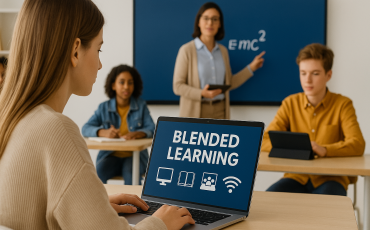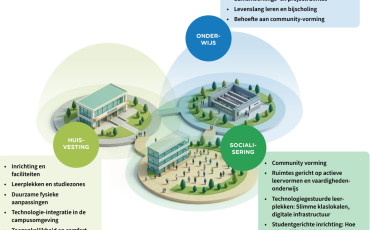Deze maand: Hoe hybride - en blended onderwijs dankzij AI en pedagogische vernieuwing het onderwijs radicaal herdefiniëren.
Mulenga, R., & Shilongo, H. (2025). Hybrid and blended learning models: Innovations, challenges, and future directions in education. Acta Pedagogia Asiana, 4(1), 1–13. https://doi.org/10.53623/apga.v4i1.495
Tanja Beks heeft dit artikel voor je uitgekozen. Als onderwijskundige bij de Breda University of Applied Science (BUAS) ondersteunt zij instellingsbreed verschillende academies en biedt ze expertise in het AI-programma.
Wat je in dit artikel leest
Deze review onderzoekt hoe hybride en blended learningmodellen het onderwijs transformeren door technologie en vernieuwende leerstrategieën te combineren. Innovaties zoals kunstmatige intelligentie, adaptieve leerplatforms en virtual reality (VR) maken gepersonaliseerd, flexibel en interactief leren mogelijk. Pedagogische benaderingen zoals flipped classrooms, competentiegericht onderwijs en microlearning zetten de student centraal en bevorderen actief leren. Tegelijkertijd worden uitdagingen besproken, waaronder de digitale kloof, werkdruk voor docenten en motivatieproblemen bij studenten. De auteurs reiken best practices aan zoals interactieve leermiddelen, continue formatieve toetsing en flexibele leerroutes om deze knelpunten aan te pakken. Tot slot schetst de publicatie toekomstperspectieven waarin technologie hybride onderwijs verder personaliseert en verduurzaming en toegankelijkheid vergroot.
Waarom we dit artikel hebben geselecteerd
Deze publicatie is relevant voor iedereen die betrokken is bij onderwijskundige innovatie en digitalisering. De auteurs behandelen zowel de technologische als pedagogische componenten van hybride onderwijs, en koppelen deze aan concrete uitdagingen en oplossingen. Het artikel biedt bruikbare inzichten voor onderwijsprofessionals die hybride modellen willen implementeren of verbeteren. De combinatie van praktijkgerichte aanbevelingen, kritische reflectie op belemmeringen zoals ongelijkheid en werkdruk, en een blik op de toekomst maakt deze studie waardevol. Bovendien sluit de bespreking van AI en VR aan bij actuele discussies over digitalisering en personalisering van het onderwijs. De toegankelijkheid van het artikel als open access bron maakt het bovendien breed beschikbaar voor toepassing in beleid, praktijk en onderzoek.
Hoe sluit dit aan op je onderwijspraktijk?
Is het voor jou herkenbaar dat studenten in een asynchrone leeromgeving sneller hun motivatie verliezen? Hoe ga je in jouw lespraktijk om met het combineren van face-to-face en online interacties?
Specifieke vraag over deze publicatie: De auteurs benadrukken het belang van technologische innovaties zoals AI en VR voor gepersonaliseerd leren. In hoeverre acht jij het realistisch dat deze technologieën op korte termijn breed geïmplementeerd worden binnen jouw instelling, gezien de huidige middelen en expertise?
Kennis over blended learning opdoen
De Special Interest Group (SIG) Blended Learning en de Vraagbaak Online Onderwijs hebben de handen ineen geslagen. Elke maand selecteren deze twee SURF-communities speciaal voor jou een relevant wetenschappelijk artikel over blended learning dat interessant is om te lezen. We stellen je een prikkelende vraag en we stimuleren je om naar je onderwijs / omgeving te kijken en je kennis en ervaring te delen. We vinden het geweldig als je jouw antwoord hieronder of op LinkedIn met ons wil delen!
Eerder verschenen in deze serie:
- Deel 1: Docentstrategieën voor betrokkenheid.
- Deel 2: Peerfeedback bij blended learning.
- Deel 3: De effectiviteit van blended learning meten.
- Deel 4: Gevoel van leren bij actief leren.
- Deel 5: Professionalisering bij blended learning.
- Deel 6: Blended learning als leermodel.
- Deel 7: Het belang van face-to-face onderwijs bij blended learning.
- Deel 8: Het TPACK-model als kader en ontwerpmodel.
- Deel 9: Het studentenperspectief op leren in een actieve en blended onderwijscontext.
- Deel 10: Gepersonaliseerd leren in blended leeromgevingen.
- Deel 11: Hoe studenten meer regie nemen in hun leerervaring.
- Deel 12: De rol van onderwijseigenschappen bij het voorspellen van academisch succes.
- Deel 13: Studiesucces verhogen met peer-learning zelfregulatiestrategieën.
- Deel 14: Blended Learning ontwerpprincipes voor onderwijs gericht op duurzaamheid.
- Deel 15: Flexibeler, toegankelijker onderwijs door minder on-campus en meer online tijd.
- Deel 16: Blended learning, strategische visie en behoeften van de onderwijspraktijk.
- Deel 17: Blended learning, Learning Analytics en formatief handelen.
- Deel 18: Effectief blended learning ontwerp voor betere studentprestaties en beter welzijn.
- Deel 19: AI in Blended Learning, een brug naar effectiever onderwijs.
- Deel 20: Didactiek eerst, of technologie eerst?
- Deel 21: Het effect van keuzevrijheid in de combinatie van traditioneel en online onderwijs
- Deel 22: AI als gamechanger én uitdaging
- Deel 23: Digitale afleiding verminderen bij blended learning
- Deel 24: Belang van zelfregulerend leren bij blended learning
- Deel 25: De effectiviteit van een flexibel blended learning studieprogramma
- Deel 26: Blended learning heruitgevonden door AI en digitalisering
The Science behind Blended Learning | Part 27: Hybrid and blended learning models. Innovations, challenges, and future directions in education.
Mulenga, R., & Shilongo, H. (2025). Hybrid and blended learning models: Innovations, challenges, and future directions in education. Acta Pedagogia Asiana, 4(1), 1–13. https://doi.org/10.53623/apga.v4i1.495
Tanja Beks selected this month's article. She works as an education specialist at Breda University of Applied Sciences (BUAS). She supports the academies institution-wide and provides expertise in the AI programme at BUAS.
What to expect in this article
This review explores how hybrid and blended learning models are transforming education by combining technology and innovative learning strategies. Innovations such as Artificial Intelligence, adaptive learning platforms and Virtual Reality enable personalised, flexible and interactive learning. Pedagogical approaches such as flipped classrooms, competence-based education and microlearning put the student at the centre and promote active learning. At the same time, challenges are discussed, including the digital divide, teacher workload and student motivation problems. The authors provide best practices such as interactive learning tools, continuous formative assessment and flexible learning pathways to address these bottlenecks. Finally, the publication outlines future prospects in which technology further personalises hybrid education and increases sustainability and accessibility.
Why we think this article is a must-read
This publication is relevant to anyone involved in educational innovation and digitisation. The authors address both the technological and pedagogical components of hybrid education, linking them to concrete challenges and solutions. The article offers useful insights for education professionals who want to implement or improve hybrid models. The combination of practice-based recommendations, critical reflection on obstacles such as inequality and workload, and a look to the future makes this study valuable. Moreover, the discussion of AI and VR ties in with current discussions on digitisation and personalisation of education. Moreover, the article's accessibility as an open access resource makes it widely available for application in policy, practice and research.
How does this align with your teaching practice?
Is it recognisable to you that students are more likely to lose motivation in an asynchronous learning environment? How do you deal with combining face-to-face and online interactions in your teaching practice?
Specific question about this publication:
The authors emphasise the importance of technological innovations such as AI and VR for personalised learning. To what extent do you consider it realistic for these technologies to be widely implemented within your institution in the short term, given current resources and expertise?
Gaining more scientific knowledge on blended learning
SURF’s Special Interest Group (SIG) Blended Learning and Vraagbaak Online Onderwijs will be working together from now on. Each month they will provide you with a relevant article on blended learning and an inspiring question. Easy, accessible and up to date. We invite you to share your thoughts on the selected articles either here or on LinkedIn.
Previous articles in this series:
- Part 1: Strategies to foster student engagement
- Part 2: Peer feedback in a Blended Learning environment
- Part 3: Evaluating the effectiveness of blended learning.
- Part 4: Measuring actual learning versus feeling of learning.
- Part 5: Professional development for Blended Learning.
- Part 6: Blended learning as an instructional model in vocational education.
- Part 7: How face to face activities impact the effect of Blended Learning.
- Part 8: The TPACK and Multimodal model as framework for designing and implementing blended learning.
- Part 9: Student perspectives on learning experiences in a higher education active blended learning context.
- Part 10: Personalized learning in higher education settings.
- Part 11: How students take more direction in their learning experience.
- Part 12: Students matter the most in learning analytics. The effects of internal and instructional conditions in predicting academic success.
- Part 13: Increasing study success using peer-learning self-regulation strategies.
- Part 14: Developing Design Principles for Sustainability-Oriented Blended Learning in Higher Education.
- Part 15: Well-designed blended learning with half of the study time online, yields comparable learning outcomes to on-campus education.
- Part 16: Blended Learning, strategic vision, and needs of educational practice.
- Part 17: Supporting students’ basic psychological needs and satisfaction in a blended learning environment through learning analytics.
- Part 18: Effective design of blended learning to increase student performance and improve well-being.
- Part 19: AI in Blended Learning, the bridge to more effective education.
- Part 20: Didactics first, technology second?
- Part 21: A combination of lectures, interactive workshops, and online resources improved student engagement.
- Part 22: Lecturers’ perspectives on the impact of artificial intelligence in blended learning.
- Part 23: Strategies to reduce digital distraction in blended learning
- Part 24: How self-regulated learning can improve the performance of students in blended and online education.
- Part 25: The effective blend - which four design factors remain?
- Part 26: Blended Learning reinvented - where AI and digitalisation are transforming education
Photo by MagicPattern on Unsplash



0 Praat mee